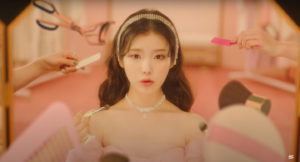
In our first End-of-Year Review of 2021, we shared the year’s strongest comebacks. The MV is often the centrepiece of the Korean artist’s comeback, enriching our understanding of the song or album, providing a visual anchor.
This year, Gina, Olethea, and Qing found themselves without a single pick in common. As discussion unfolded, however, they discovered the thinking behind their choices bore similarities. From dreamy MVs conveying comfort or solitude, to bold, imaginative concepts fusing traditional with the modern, the works inspiring emotional connections stood out most.
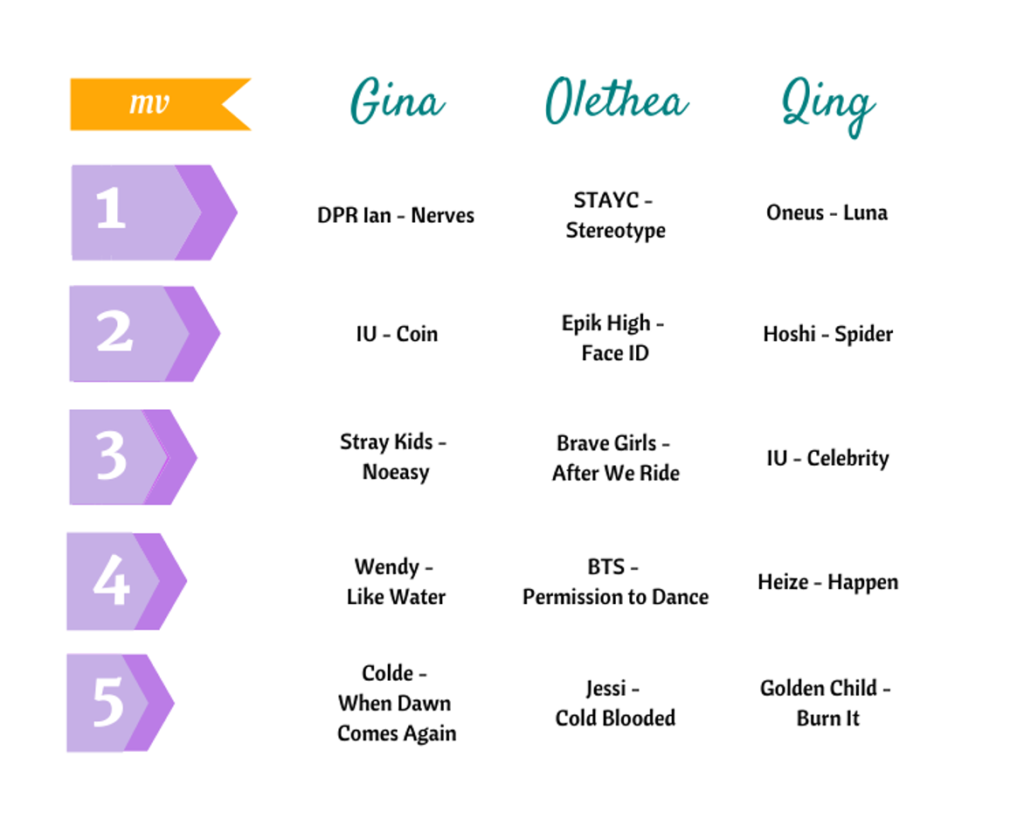
Qing: With a great spread to choose from, I’m not surprised we ended up with diverse picks. My criteria for MVs has evolved. I used to look for creativity and accessible ideas connected to technique (visual choices, cinematography, editing). I now factor in emotional impact, how the MV creates or supports the artist’s identity, and whether the visual choices are responsive to musical elements.
How do you define a good MV, and how do your picks exemplify these qualities?
Olethea: Eye-catching visuals creating a consistent aesthetic is an important element for me. Though MVs are a visual storytelling medium, I believe a storyline isn’t always necessary.
StayC’s “Stereotype” tops my list despite being simple. It reminds us not to view StayC through a stereotypical lens, but adore them for who they truly are. While the message is presented in a weak manner, the MV is a colourful treat.
The hi-teen aesthetics stand out, especially through their use of bright colours and eye-catching Y2K fashion. From the uniforms and cheerleader fits to the gowns and eyeliner, and of course J and Yoon’s unique hairstyles, the styling works seamlessly to affirm that girls, too, can be unconventional.
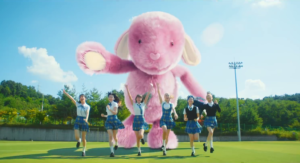
Another element that cannot be left out is the use of CG. Though the giant flying bunny doll feels uncanny, the subtle CG during Isa’s solo part and in the final dance sequence elevates the visual experience, tying the MV together.
Together, “Stereotype” is a neatly wrapped present with a bow on top. It’s everything I want in a girl group. It’s simple yet pretty, dreamy, and not overly cute, succinctly encapsulating the teen crush concept befitting StayC.
Gina: For me, it depends on how innovative the MV is as a storytelling platform. My choices are listed according to the creativity involved in portraying the visual elements and theme of the song, if it enhances storytelling, and if all elements of this comeback work cohesively.
Topping my list is DPR Ian’s disjointed but glorious “Nerves”—a post-breakup hit detailing a mental breakdown. All components of the production are intrinsically linked. The lyrics match where Ian spirals in self-destruction; the song swings back and forth in tension, depicting his growing insanity.
Objectively, there’s not much going on besides Ian performing, being haunted by flashbacks, and descending into madness. Still, every detail counts. The disordered camerawork adds to the MV’s raw, grungy messiness, keeping us on edge as we traverse through Ian’s regrets. Ian’s acting skills not only made the story more believable, but also palpable. As my first encounter with Ian, “Nerves” surprised me with how authentic his approach to his work is.
Qing: In contrast to the raw approach “Nerves” takes, Oneus‘ “Luna” is steeped in elegance and symbolism. The visuals take their cue from the song’s mix of traditional Korean instruments, synthpop, and trap elements. Despite combining various genres, there’s a clean sound; the scenes accompanying the wistful verses respond to this, using empty space and stark silhouettes.
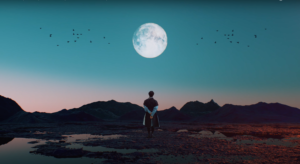
As more sonic elements are introduced, the lighting becomes saturated, and choreography scenes add movement. This climaxes in the flurries of snow, spinning back-up dancers, and fluttering of silk fans and white ribbons in the chorus and post-chorus.
The natural imagery aptly reflects the song’s theme of an estranged lover, which Sara explained excellently. The careful orchestration of these images emphasises the music’s ebb and flow. “Luna”‘s execution isn’t the most skilled, but the sheer force of its artistic ambition and emotional impact won me over.
Olethea: Like Oneus’ “Luna”, Epik High’s “Face ID” relies on symbolism. Initially, the MV feels disorientating, trippy, and messy. Yet, its vivid colours and use of mismatched body parts to symbolise the anonymous identities of online trolls makes “Face ID” a visual museum.
Two elements caught my eye. First, the recurring image of mismatched body parts stylishly puts forth the message online trolls are faceless; thus, they could be anyone. The MV dramatizes this by piecing together a giraffe head and human body, even a beagle head and human body.
Secondly, the MV plays with size and perspective, making it dynamic while evoking a sense of claustrophobia. When the rappers are in the middle of the screen, they’re surrounded by dancing skeletons, half-human figures, and giant human heads. They appear smaller, similar to how one would feel after getting attacked by keyboard warriors.
In classic Epik High style, the injection of humor with DJ Tukutz’s dance scene will always be a win for me.
Gina: Watching Oneus’ “Luna” reminded me of VIXX’s “Shangri-La,” which Qing reviewed in meticulous focus. Not only are aesthetic similarities prominent, but the balance in cultural time lapses is articulated in perfect harmony.
This mesh of modern and historical East Asian culture continues with Stray Kids’ “Noeasy,” although the use of historic aesthetics is flipped. The magic is instead found in its direct contrast: with a historical, live-action background, the members dance in street and luxury fashion. Celine, Chanel, and Givenchy flash as the group dances alongside namsadang and pungmul performers. The background crowd wearing traditional hanbok garb, living in huts, and walking on dirt roads enhance the set and visual contrast.
Altogether, it’s an innovative move to utilize traditional instrumentals for not only auditory but also visual purposes. The juxtaposition of two entirely different aesthetics is not only memorable, but brings the song to life. With song and production working together this way, the MV dares to combine two-in-one successfully.
Qing: While Oneus and Stray Kids’ MVs go for stylistic duality, IU‘s “Celebrity” incorporates duality as part of its gentle message of reassurance from IU to herself. The MV drops us in a dreamy, posh world where IU dresses beautifully like a princess. This aligns with the rest of IU’s often fantastical MVs.
But something is incongruent with the soft, glowing lighting and twinkling gemstones: the camera always tilting, and a dozen pairs of legs stepping on IU’s royal blue cape. These images of disorientation and entrapment continue throughout the MV as we see celebrity IU constantly pursuing her non-celebrity self, who is happier and more carefree.
By the end of “Celebrity”, IU realises she exists beyond her celebrity identity, and she can break free if she so chooses. This delicate, earnest offering of a moment of self-discovery, styled consistent with IU’s whimsical visual oeuvre, is what placed “Celebrity” high on my list.
Did any MVs stand out to you for their narratives?
Gina: If “Celebrity” induces comforting reassurance and “Lilac” a recollection of sweet youth, IU’s “Coin” sheds a spotlight on life’s gambles, with its unpredictable challenges and consequences. It depicts IU as a top-notch gambler who shoots to the top, only to be toppled down by an unexpected force.
But in the end IU returns the coin, owning her personal challenge and learning from it. The key moment is this choice, reminding us we can embrace and grow from our experiences. This lesson goes hand-in-hand with the premise of her Lilac comeback: a reflection of the season where youth and growth are constantly intertwined together.
“Coin” is also a reminder that no matter the age, we can try new things. While this MV doesn’t have as many views as her more popular title tracks, it’s a hidden gem: she’s confident and unbothered while performing, owning a theme not always explored. Departing from traditionally dreamy and fairytale-like settings which served her well, we get a glimpse into IU’s growth as artist and storyteller.
Qing: Heize‘s “Happen” and Golden Child‘s “Burn It” stood out for a similar reason, using surface narrative to reflect deeper themes.
“Happen” highlights the capricious nature of fate: it can bring about meetings that may turn into deeper acquaintance, but it can also result in interactions that remain nothing more than coincidences. The MV has a distinct style drawing from the paintings of Edward Hopper (Office in a Small City, Morning Sun, Nighthawks), known for portraying solitude in urban spaces. The synergy between this artistic reference and “Happen”‘s narrative adds an emotional dimension to its philosophical musings.
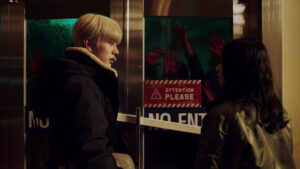
“Burn It” draws on T-ara‘s legacy of cinematic, post-apocalyptic MVs, refined by focusing the narrative on a clear message of empathy. The MV’s desaturated palette and zombie apocalypse imagery fit the tender yet desolate soundscape, which rings with an earnest promise of acceptance. It may not be as skillfully made as my other picks, but it’s thoughtfully made, and is one of the most poignant MVs I’ve seen in a while.
Olethea, you have more dance-focused MVs on your list; what did you like about them?
Olethea: My picks are quite different from you two! Though unlike your usual MV, Jessi’s “Cold Blooded” gave me goosebumps in the best way possible. While the song was initially mediocre, the choreography made the song twofold better. I couldn’t count the number of times I replayed it to watch each Street Women Fighter crew individually. Needless to say, nothing beats how satisfying it is to watch dancers be in their element.
As a whole, “Cold Blooded” leaves a strong impression. Not to mention, it’s always heartwarming to see confident, powerful women come together, especially ones equally matching Jessi’s strong image and charisma.
While BTS’ “Permission to Dance”’s choreography was inclusive with its incorporation of sign language, and suited for TikTok challenges, that wasn’t why it made it to my list. Instead, it’s their optimistic message that grants the song and MV its feel-good factor.

BTS’ message is heartfelt and it speaks to the masses. While this is the new normal now, I’m looking to go back to the “old normal”. Though, admittedly, this will likely take longer as compared to BTS’ prediction of 2022, I, too, cannot wait to “live just like we’re golden”. Call me sentimental, but I can imagine myself watching this a year or two later and remembering the small moments of hope in the midst of this darkness, which I’ll associate “Permission to Dance” with.
Qing: Hoshi‘s “Spider” takes a more layered artistic approach to the dance MV. It’s downright virtuosic in its deconstruction and reimagination of a spider’s appearance and predatory behaviour. The furry, berry-red rug is a reimagined tarantula. Its glassy eyes find new form in Hoshi’s rings. The shimmering silver threads in his top and streaks of luminous paint are reminiscent of a spider’s web.
Executed with a bold creative vision and technical precision, “Spider” brings out Hoshi’s sensuality and power as a performer. It’s the most well-rounded work on my list, but my top spot went to “Luna” because it made me feel more deeply. Technique is important, but I believe emotional connection is what makes good art most of all.
Olethea: I always enjoy MVs referencing previous MVs and Brave Girls’ “After We Ride” is just that. While their previous MVs lack depth, this time, Brave Girls pulled through with a storyline that matches well with an equally mellow song.
The acting, colours, angles, and camera movements create a dynamic yet wistful MV. I appreciate how the members were mostly seen alone in wide-open spaces while trying to cope with post-breakup grief. Not only does this exhibit loneliness and nostalgia, it also cleverly features places (a karaoke room, a pool, a bar) used to be filled with people.
Moreover, the smooth incorporation of alcohol into the shots, be it in a bar, the members holding a glass of wine, or looking tipsy, this recurring motif not only perfectly ties in all the different scenes together but also speaks to its Korean title, 술버릇 (drinking habits).
Gina: Wendy’s “Like Water” and Colde’s “When Dawn Comes Again” stand out for their tranquil stillness, if not inner loneliness.
Wendy’s MV reminded me of Taeyeon’s “Four Seasons,” as each moment is captured like an artistic portrait, with the singer as the revered subject. There’s a mesmerizing, aesthetic quality to every scene, as they glide on like water, resembling watching remnants of a dream.
This dreamy atmosphere meets stunning quality, as the many uses of flowers and artistic symbolism showcase the diversity of water as a thematic concept. The concept is clear without being overbearing, and we are able to bask in the warmth and loneliness of Wendy’s love story.
Colde’s MV is similarly entrancing, as it dwells on the stillness of dawn and its muted blue atmosphere. We are drawn into unknown daydreams, and the quiet of the city before it wakes up. Within this backdrop, Colde’s melodic yet melancholic voice portrays the deep emptiness prevailing throughout the song: a chilling combo that resonates long after the track is over. Usually this approach can be hit-or-miss, but Colde and his team struck the perfect balance between aesthetics and mood.
(YouTube [1][2][3][4][5][6][7][8][9]. Images via Big Hit Music, Edam Entertainment, High Up Entertainment, Woollim Entertainment)


